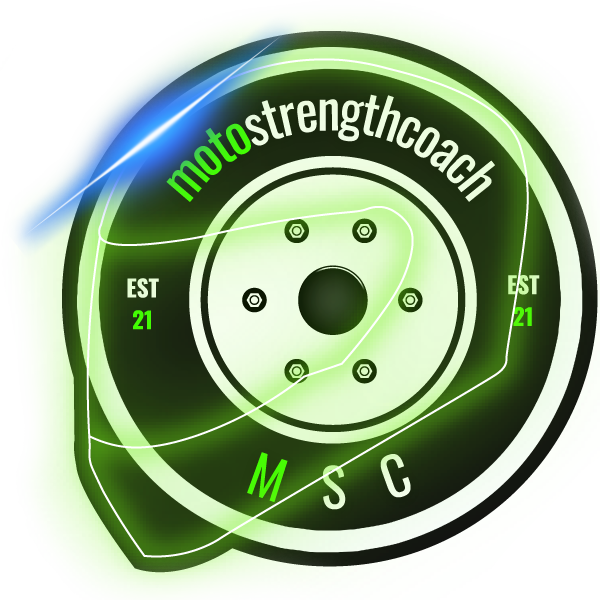Rider Strength and Conditioning Analysis:
A Comprehensive Guide to the
STRUF Analysis Tool
Meta Description:
Abstract
This paper introduces the Strength Through Range Under Fatigue (STRUF) Analysis Tool—a strength & conditioning assessment tool designed to optimize a motorcyclist’s physical capabilities. It explores the methodology, metrics, and outcomes of using STRUF as part of an overall fitness strategy for performance-oriented motorcyclists.
Part I: The Science of STRUF – Unveiling Rider Potential
1.1 Introduction to STRUF
STRUF is a rigorous, scientifically designed analysis tool tailored to the unique needs of performance-oriented motorcyclists. Developed by an expert in strength and conditioning with a drive to ride, it measures a rider’s physical abilities under stress conditions mimicking those encountered during riding, providing actionable insights into improving those abilities over time.
1.2 Physiological Targets of STRUF
STRUF strategically tests:
Muscular Strength: Measures the force muscles can exert, focusing on the posterior chain, vital for controlling a motorcycle.
Cardiovascular Endurance: Analyzes the body’s ability to sustain prolonged physical activity, critical for long rides.
Mobility: Assesses the range of motion around key joints, directly affecting a rider’s control over the bike.
Reaction under Fatigue: Evaluates decision-making capacity under physical stress, replicating the conditions of a long ride or race.
1.3 Technological Backbone
STRUF integrates wearable technologies (e.g., heart rate monitors) and leverages the MotoStrengthCoach app to offer live feedback and data tracking. This tech-driven approach allows precise, granular tracking of progress over time and quick adaptation of training regimes. Our aim is the adaptation of spatial computing once the technology becomes more prominent.
1.4 Safety Protocols in STRUF
Safety remains paramount. STRUF exercises are engineered to challenge riders while minimizing the risk of injury.
Part II: Metrics, Methodology, and Mastery – Understanding the STRUF Analysis Tool
2.1 Comprehensive Metrics
STRUF uses a plethora of metrics—HR patterns, lactate threshold, VO2 max, flexibility index, muscle fatigue rate, etc. These metrics offer detailed insights into the current physical state of a rider.
2.2 Interpreting Your Data
STRUF uses analytics to interpret your data. Data points are interpreted through a multi-layer analysis, revealing critical insights such as potential for injury, areas of strength, and opportunities for performance enhancement.
2.3 Link Between STRUF Metrics and Riding Performance
For example, a rider with improved lower body strength (measurable via squat and deadlift performance in STRUF analysis) may find improved bike control in arduous conditions, while greater cardiovascular endurance (measurable via HR recovery rate post-STRUF workout) may correlate with fatigue-free decisions and longer, more comfortable rides.
2.4 Strategic STRUF Integration for Teams
For teams, STRUF is more than just an individual assessment tool. It can act as a critical team-building and synchronization tool, allowing for collective challenges and group analytics.
Part III: Your Personalized Roadmap – From STRUF Analysis to Peak Performance
3.1 The Individuality of STRUF
Every STRUF analysis results in a unique profile—identifying individual strengths, weaknesses, and critical areas for focus. This personalized fitness profile is used to tailor specific training regimens.
3.2 Creating Your Custom Training Plan
Post-analysis, the user receives an actionable training program designed to target identified areas. This isn’t a one-size-fits-all plan but is meticulously tailored based on the unique STRUF profile of the individual.
3.3 Success Stories – STRUF in Action
“Jet, a motocross athlete, saw an improvement in his race timings post incorporating STRUF recommendations. His increased strength endurance significantly enhanced his bike control through normal end of race fatigue.”
“Chris, after their STRUF-integrated training, came first, placing higher than expected in a world class event, attributing their success to better physical synchronization and individual training.”
“Shane, during their STRUF-integrated training in the off season, stated, ‘It was surprising, I wasn’t sore or tired, so the training is working across all sports.’”
3.4 Continuous Improvement with STRUF
STRUF is designed as a continuous improvement tool. Regular re-assessment ensures the training program evolves with the rider, continually pushing towards new milestones.
Conclusion
The STRUF Analysis Tool is not just a fitness assessment—it’s a revolutionary approach to motorcyclist training. By bridging the worlds of professional strength and conditioning training and high-performance motorcycling, STRUF provides a unique, science-backed path to improved performance and safety on the road.
Appendices
Technical specifications of the STRUF Analysis Tool
Scientific literature references validating STRUF’s methodology (Not Currently Available)
Expanded user testimonials and case studies
Ready to redefine your riding experience? Try the STRUF analysis today and unleash your true riding potential.
Appendices
Technical Specifications of the STRUF Analysis Tool
System Requirements:
Hardware:
Compatible with wearable fitness tracking devices (heart rate monitors, GPS, accelerometers)
Requires a smartphone or tablet with Bluetooth 4.0 or higher (iOS 12.0+, Android 7.0+)
Software:
MotoStrengthCoach App available on iOS App Store and Google Play Store
Web dashboard accessible on Chrome, Firefox, Safari, and Edge browsers
Core Features:
Data Collection:
Continuous Heart Rate Monitoring
Muscle Activation and Fatigue Detection
GPS Tracking for Outdoor Activities
Motion Analysis using smartphone or tablet’s camera
Integration with third-party fitness and health trackers (Fitbit, Garmin, etc.)
Performance Analysis:
Real-time feedback on physiological parameters
Custom Algorithms for fatigue detection and stress analysis (future goal)
Assessment of Reaction Time under fatigue
Data analytics powered by Machine Learning
User Interface:
Interactive, User-friendly Dashboard
Real-time Data Visualization and Reporting
Secure User Profiles with Data Encryption
Connectivity:
Bluetooth and Wi-Fi Connectivity
Cloud Synchronization for cross-device compatibility
Safety Protocols:
Monitoring:
Anomaly Detection in Stress Levels or Movement Patterns
Alert System for user and/or trainer when abnormal data is detected (future goal)
API available for integration with other platforms and tools (future goal)
Future Upgrades:
Plans to adapt spatial computing technology once it becomes more prominent
Integration with Virtual Reality (VR) systems for immersive training simulations
Physical Requirements:
Suitable for indoor and outdoor environments
Requires minimal space for setup and usage (compatible with home gyms, professional training facilities, and outdoor areas)

